It calls itself the “god of frogs”, but is Pepeto (PEPETO) a legit crypto presale, or are there warning signs that you should cons...
Exchange data confirms Binance as the industry’s largest crypto trading platform by daily volume and monthly active users. This Binance review reveals everything traders need to know to make an informed platform decision.
We opened a Binance account and deposited real money to evaluate the exchange in great detail. The research team explored the most important factors, from listed cryptocurrencies and derivative markets to trading fees, user-friendliness, and overall safety.
Our Binance Review Verdict Summarized
Our research shows the exchange handles institutional-grade trading volume and deep liquidity. The platform suits intermediate-to-advanced crypto traders, and its world-class trading suite offers bespoke orders, technical indicators, and chart drawing tools. The derivative exchange supports high-leverage trades across futures and options, with both inverse and linear settlement.
Entry-level spot traders pay just 0.1% per side, and commissions are reduced when users hold BNB (BNB) or meet 30-day volume thresholds. As the world’s biggest exchange, Binance offers a safe and legitimate trading experience, yet available markets and products depend on the user’s location. U.S. clients access Binance on a dedicated U.S.-approved exchange, while other nationalities use the main global platform.
Binance Key Takeaways
- Binance is a global crypto exchange that supports over 400 digital assets and more than 1,500 trading pairs.
- The exchange offers competitive trading fees across its spot exchange and derivative platform, which includes options, perpetuals, and delivery futures.
- Binance suits active day traders who seek a professional charting dashboard with advanced research and analysis tools.
- Platform users access various ecosystem features, including savings accounts, loans, automated bots, copy trading, and launchpool events.
- Due to regulatory restrictions, Binance users in some countries cannot access certain markets, products, and services.
Binance Pros & Cons
According to our Binance review findings, the exchange offers the following benefits and drawbacks:
Pros
- Deep Liquidity: As Binance handles higher trading volumes than any other exchange, users access deep liquidity and competitive bid-ask spreads on hundreds of digital assets.
- Competitive Fees: While the maximum spot trading commission is just 0.1%, traders secure even lower fees when they trade larger monthly volumes or hold BNB. This structure makes Binance a low-fee exchange.
- Wide Asset Support: With over 1,500 crypto pairs, Binance supports the best altcoins across spot trading and derivative markets. The alpha and launchpool features provide access to brand-new coins and tokens.
- Diverse Trading Tools: Binance supports a wide range of trading tools, like technical indicators and customizable charts. Passive investment tools include copy trading and fully automated bots.
- Earn Crypto Yields: Exchange users earn competitive yields through decentralized finance (DeFi) initiatives such as savings accounts, crypto loans, dual investments, and smart arbitrage.
- First-Class Security: Binance secures over $200 billion in customer assets through cold storage wallets with multi-signature protections. In addition to two-factor authentication and device whitelisting, its Security of User Assets Fund (SAFU) holds $1 billion in USDC (USDC).
Cons
- Location Restrictions: Binance restricts certain products and services depending on the user’s location. The U.S. exchange supports a much lower range of markets, while UK users cannot access derivatives or DeFi tools.
- Learning Curve: Beginners may find that some trading features require a steep learning curve, particularly derivative markets like options and delivery futures. The trading dashboard suits intermediate-to-advanced users.
- BNB Requirements: The exchange pushes users towards its native asset, BNB, to reduce fees and enable access to launchpool events. As a volatile asset, price declines could devalue those account perks.
What Is Binance?
Launched in 2017 by founder and former CEO Changpeng Zhao, Binance is a global exchange that lists hundreds of cryptocurrencies. Users buy and sell digital assets in a deep liquid environment, and the exchange handles tens of billions of dollars in daily trading volume.
The platform claims over 290 million users, making it the most popular cryptocurrency exchange in the market. While Binance was founded in China, it now operates offices in several jurisdictions, including Malta and the Cayman Islands. It also operates a separate exchange for U.S. clients, which has received state and federal approval.
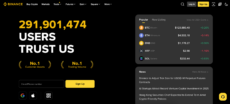
With over 290 million users, Binance is the world’s most popular crypto exchange. Source: Binance
Binance’s most popular product is its spot trading exchange, which charges entry-level commissions of just 0.1%. High-volume spot pairs include BTC/USDT and ETH/USDT, as well as top meme coins like DOGE/USDT and SHIB/USDT. The derivative platform generates significant volume across perpetual and delivery futures and diverse options chains. These markets offer a maximum leverage multiplier of 150x.
The Binance ecosystem features several DeFi products that enable account holders to earn passive income. Savings accounts offer competitive yields with flexible and fixed terms, while advanced tools such as smart arbitrage and dual investments provide a higher risk-reward spectrum. Other passive tools include copy trading and preset bots.
Binance’s Products & Services
Binance’s comprehensive exchange offers multiple ways to buy, sell, and trade cryptocurrencies online. To invest in digital assets, users trade crypto pairs on the spot exchange by placing market or limit orders. The order book system matches buyers and sellers at their requested prices. Investors also purchase coins and tokens directly with instant payment methods like Visa and MasterCard.
The peer-to-peer (P2P) exchange suits buyers who want to purchase digital assets from local sellers, which enables them to use domestic payment methods and currencies. In addition to traditional trading, Binance offers an extensive derivatives platform. It allows users to trade long and short with leverage across futures and options markets.
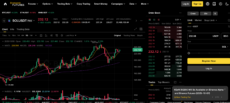
Binance offers extensive derivative markets across futures and options. Source: Binance
Binance appeals to investors who seek passive income on their idle exchange balances. Stablecoins like Tether (USDT) and USDC offer yields of up to 10.5% on flexible savings accounts, while dual investments provide potential APYs of several hundred percent. To increase market exposure, users may borrow digital assets via the built-in loan service.
Our Binance review shows the platform offers access to new cryptocurrencies with significant upside potential. The launchpool lets users invest in pre-listing tokens at a reduced valuation, and the alpha platform supports low-cap assets from Base, BNB Chain, and other decentralized ecosystems. Web 3.0 investors may also trade popular NFT collections on the Binance marketplace.
Which Cryptocurrencies Can You Trade on Binance?
The main Binance exchange supports over 400 coins and tokens, which translates to more than 1,500 trading pairs. Traders access the best cryptocurrencies to buy, like Bitcoin (BTC), Ethereum (ETH), Solana (SOL), and BNB. Complete beginners may purchase these assets directly with traditional money, or trade them against USDT, USDC, and other stablecoins.
Besides major altcoins, the spot exchange lists digital assets by investment category. Examples include metaverse, payments, real-world assets (RWA), and specific ecosystems like Solana and BNB Chain.
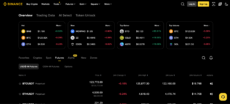
Binance lists over 1,500 trading pairs, including top RWA and DeFi tokens. Source: Binance
Binance supports over 600 perpetual and delivery futures through linear and inverse contracts. Most derivative markets use USDT, although large-cap pairs also support USDC. Options traders access six USDT-paired chains, including Dogecoin (DOGE), BTC, and ETH.
Since American traders rely on the Binance.US exchange, they access a much smaller selection of markets. The U.S. platform lists about 180 assets via spot trading, with no support for derivatives.
Binance Fees
Binance trading and non-trading fees vary by several factors, including order types and average 30-day volumes. This section explains what charges to expect as a Binance user.
Spot Trading Fees
Our Binance review found that spot traders never pay more than 0.1% per side (entry and exit orders). This makes Binance considerably cheaper than other tier-one spot exchanges like Coinbase and Kraken, which charge up to 1.2% and 0.4%, respectively.
The Binance exchange has nine VIP tiers based on trading volume. The highest account tier offers a minimum trading commission of 0.011%. Most account tiers allow users to reduce their commissions when they place limit orders. BNB holders receive a 25% discount on standard commissions, too.
Binance runs regular promotions, where selected pairs offer commission-free trading. Existing examples include BTC/FDUSD and AAVE/FDUSDT.
Derivative Trading Fees
Derivative commissions depend on the trading product. Perpetual and delivery futures with linear or inverse settlement initially cost 0.02% (makers) or 0.05% (takers). In contrast, MEXC charges 0.04% and 0.01%, which is slightly cheaper than Binance.
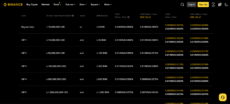
Binance futures trading fees depend on the VIP tier, order type, and whether users hold BNB. Source: Binance
Similar to the spot trading framework, Binance traders receive discounted fees when they hold BNB (10%) or increase their VIP tier. Large-scale futures traders who place limit orders get 0% commissions, while market orders cost 0.017%.
Note that futures commissions are lower than the spot exchange, yet Binance charges them against the total leveraged position size. Perpetual contracts also incur funding fees every eight hours. The platform charges funding rates based on the pair and settlement type.
When trading options, makers and takers pay the same commission regardless of their VIP level. The flat fee on contract settlement is 0.024% for all users.
Non-Trading Fees
Binance does not charge deposit fees when users transfer cryptocurrencies from a private wallet or another exchange account. Investors pay variable fees to purchase digital assets with instant payment methods. Visa and MasterCard payments average 2%, although specific fees depend on the fiat currency.
The exchange uses a flat-fee structure for crypto withdrawals, and each coin or token has a separate charge. Bitcoin and Ethereum withdrawals cost 0.00003 BTC and 0.0002 ETH, which reflects competitive pricing.
| Max Spot Commission | 0.1% |
| Max Futures Commission (market) | 0.05% |
| Max Futures Commission (limit) | 0.02% |
| Funding Fees | Perpetuals only. Variable fee every eight hours, depending on the market |
| Standard Options Commission | 0.02% |
| Average Debit/Credit Card Fee | 2% |
| BNB Discounts | 25% (spot), 10% (futures) |
| Crypto Deposits | Free |
| Crypto Withdrawals | Flat fee varies by coin and token |
User Experience: Is Binance User-Friendly?
We tested the Binance trading platform to evaluate user-friendliness and the required learning curve for beginners. Inexperienced users buy cryptocurrencies with traditional payment methods. They simply enter the required asset, purchase amount, and payment type, and Binance executes at the best available price. The conversion tool also suits novice traders, since users swap cryptocurrencies without using the main spot exchange.
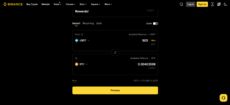
Binance’s conversion tool helps beginners trade assets without traditional order books. Source: Binance
The spot exchange appeals to intermediate to advanced traders. It offers proprietary charting tools on web browsers, as well as native desktop software for Windows and Mac. Each version supports customizable charts and analysis tools like the RSI and Moving Averages. To assist traders with limited experience, Binance offers a simulation tool that mimics real market movements. The tool provides virtual funds with zero investment risks.
Perpetual and delivery futures share a similar charting layout, and although the user experience remains smooth, these products are primarily aimed at experienced derivative traders. Binance does, however, offer a simplified dashboard for crypto options. Instead of reviewing complex options chains, beginners enter their market predictions, and Binance suggests the most suitable call or put contract.
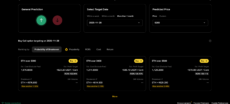
Binance Simple Options helps inexperienced traders buy and sell options contracts. Source: Binance
The new onboarding process resembles regulated exchanges like Gemini and Crypto.com. Users must complete enhanced KYC verification to access payment facilities. New customers provide personal information, ID documents, and a recently issued proof of address. As such, the top no-KYC crypto exchanges are a better fit for traders who favor anonymity.
Binance Mobile App
Binance has one of the most popular crypto trading apps available. Across over 3.5 million reviews, iOS and Android users rate the app 4.9/5 and 4.7/5, respectively. The mobile trading experience offers full functionality with optimized charts and simplified order processes.
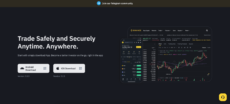
Binance offers a highly rated trading app for iOS and Android users. Source: Binance
Account holders access the same trading markets as the main desktop version, including conversions, spot exchange, and derivatives. We found that the app is ideal for monitoring existing crypto portfolios via custom alerts. Users receive a real-time push notification when triggered.
Note that Binance offers dedicated apps for traders in some countries, including the U.S. and Thailand. These versions provide a more localized experience, including domestic payment methods and currencies.
Features & Tools
In this section of our Binance review, we explore the exchange’s most popular features and tools.
Crypto Leverage
Binance ranks as one of the best crypto trading leverage platforms. Traders receive leverage of up to 150x on major pairs like BTC/USDT, which magnifies a $100 position size to $15,000.
Leverage multipliers vary by pair, initial margin, and whether users trade inverse or linear futures.
Simple Earn
Simple Earn resembles crypto savings accounts. Fixed and flexible terms are available, and supported assets like USDC, USDT, BTC, ETH, and BNB.
Users deposit account assets into a Simple Earn product and earn passive yields accordingly. Interest rates are low on some accounts, such as 0.25% on BTC and 2.45% on ETH. In contrast, USDT yields APYs of over 10%.
Trading Bots
Bots provide a passive trading experience for spot and futures traders. Users choose between sideways, bullish, and bearish systems, and strategies include arbitrage, dollar-cost averaging, and rebalancing.
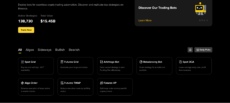
Binance trading bots place buy and sell orders 24/7 via pre-built strategies. Source: Binance
The marketplace provides pre-built bots with profit-sharing agreements, and once activated, they trade autonomously 24/7. Experienced traders may set custom parameters from the ground up.
Crypto Loans
Binance users borrow funds for extra spot and futures trading capital, and to amplify DeFi yields. While the platform charges interest hourly, major cryptocurrencies offer competitive APRs.
To borrow BTC, users secure an initial loan-to-value of 78% at APYs of just 0.478%. Stablecoins have less favorable terms. Those who borrow USDT or USDC pay APRs of over 7% and 9%.
Binance Card
Available in Brazil exclusively, the Binance Card lets users make real-world purchases with their exchange balance. The MasterCard-issued debit card works at millions of online and in-store merchants, and most ATM networks.
Cardholders earn cashback rewards of up to 2%, yet Binance caps monthly payouts to 120 BRL.
Launchpool
The launchpool feature provides access to new crypto tokens. Users stake BNB and other designated assets to receive airdrop rewards from the launchpool project.
Since Binance lists launchpool tokens (usually on the alpha platform) on its exchange after the event, airdrop rewards sometimes generate attractive price gains.
Binance Wallet
Binance offers two separate wallets to store crypto investments.
When users buy coins and tokens on the exchange, Binance adds those assets to the standard account balance. This framework represents custodial storage, as the exchange controls private keys and seed phrases. Therefore, to transfer cryptocurrencies from the centralized Binance wallet, users wait for the platform to approve their withdrawal request.
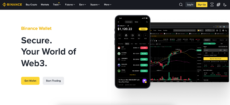
Binance’s Web3 wallet provides a non-custodial storage experience. Source: Binance
Binance’s Web3 wallet offers non-custodial storage for iOS and Android smartphones, and Chrome and Brave browser extensions. Users fully control their wallet credentials, so they store digital assets in a decentralized environment. The non-custodial solution supports 34 networks, including Bitcoin, Ethereum, Litecoin, and Dogecoin.
Experts recommend non-custodial wallets to avoid counterparty risks. While active Binance traders use the built-in web wallet for enhanced convenience, experts discourage storing consequential amounts. If Binance experiences hacking exploits or financial issues, user assets could be at risk.
Deposits & Withdrawals
Binance’s deposit and withdrawal methods depend on the user’s country of residence. Traders in some countries may buy cryptocurrencies instantly with Visa and MasterCard.
European users also access SEPA bank transfers, plus e-wallets like Apple Pay and Google Pay. Debit/credit cards and e-wallets average 2%, and SEPA costs just €1 irrespective of the deposit amount. On Binance’s U.S. exchange, users deposit and withdraw via ACH without paying transaction fees.

Binance accepts popular fiat payment methods like Visa, MasterCard, and Apple Pay. Source: Binance
Our Binance review found some nationalities use the P2P exchange to purchase assets with local methods. It supports over 800 additional payment options, including domestic bank transfers, mobile top-ups, Neteller, Skrill, and Cash App. Binance does not charge P2P fees to buyers. However, since sellers choose their own fiat-to-crypto exchange rate, purchase fees may be above or below the spot price.
Any supported nationality can deposit cryptocurrencies via wallet transfers. No deposit fees apply, and payments often arrive in seconds.
The exchange has varying minimum and maximum limits depending on the currency, payment method, and KYC verification level. For example, U.S. users may deposit just $5,000 daily via ACH, but those limits increase to $7.5 million for domestic wire transfers.
How Secure Is Binance?
Binance manages over $200 billion for exchange users, so it employs tier-one security practices to ensure client fund safety. It keeps the majority of customer assets in secure cold storage wallets, which mitigates online vulnerabilities. 24/7 security teams monitor asset movements and general exchange activity, and published proof of reserves verify that the exchange covers client deposits by at least 100%.
The platform’s SAFU reserve holds over $1 billion in USDC holdings. SAFU functions as an insurance fund in the event hackers steal client funds. However, the $1 billion reserve reflects a small percentage of Binance’s overall customer balances.
Account holders must activate two-factor authentication, which requires an SMS and email code for each login and withdrawal attempt. Additional security tools include IP address and device whitelisting, and anti-phishing codes.
Despite institutional-level security, hackers breached Binance’s native BNB Chain in 2023 and stole over $530 million worth of digital assets. The hack shows that cybercriminals continuously find new methods to bypass exchange security protocols. As such, crypto investors should avoid storing high-value portfolios in centralized exchanges.
Customer Support
Binance offers 24/7 customer service in multiple languages. Account holders access the live chat feature on desktop browsers or the Binance app. Users request a real human to bypass the initial bot process.
While the exchange has over 290 million users, we were connected to a customer representative in minutes. Agents handle most account queries quickly, although some issues may need manual investigation. In this instance, users typically receive a response to their registered Binance email.
Account Types
Most Binance users open standard accounts. Available products and services depend on the user’s nationality, as mandatory KYC requires a government-issued ID.
The exchange also offers sub-accounts, which permit certain permissions to secondary users, such as spot trading. Sub-accounts also help traders segregate assets for different investing strategies and improve risk management controls.
Professional traders, financial institutions, businesses, and other large-scale investors can apply for a VIP account. These accounts offer various perks, from lower fees and dedicated customer service to higher withdrawal limits.
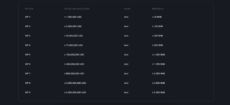
Binance offers VIP accounts to high-volume traders. Source: Binance
To qualify, applicants must trade at least $1 million (spot) or $15 million (futures) within a 30-day period. This provides access to VIP 1 only, so higher qualification requirements are needed to increase the account tier.
How to Use Binance
Learn how to get started with Binance in this step-by-step tutorial. We explain how to register, verify, and fund an account, and set up and place crypto trading orders.
Step 1: Open a Binance Account
Go to the Binance website and click “Sign Up” to register an account. The initial process requires an email address or mobile number and a strong password. New customers may also connect their Google or Apple accounts.
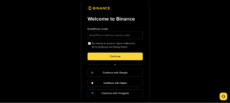
How to open a new Binance account. Source: Binance
Then, verify your chosen account contact method.
Step 2: Complete Binance’s KYC Verification
All Binance users complete a KYC process. The exchange requires a passport, driver’s license, or any other accepted government-issued ID.
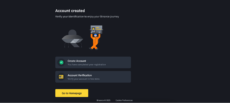
Binance users must complete ID verification before they deposit funds. Source: Binance
Binance requires a proof of address document issued within the prior 90 days. Most users upload a utility bill or bank statement, although the platform also accepts other document types.
Depending on the country of residence, Binance may require a video confirmation. The automated process asks users to hold a selfie next to their face.
Our research shows that Binance typically verifies users in several minutes.
Step 3: Deposit Funds
Binance users have various ways to fund their trading account.
To send digital assets from a private wallet, click the “Wallet” icon and select “Deposit”. Then tap “Deposit Crypto”.

Binance users can deposit any digital asset that the exchange supports. Source: Binance
Type in or select the crypto and network, and transfer assets to the provided wallet address. Since the address links to your Binance account, you track the deposit via the blockchain transaction ID.
Binance also supports fiat payments, where users purchase digital assets with traditional money. Hover over “Buy Crypto” and complete the payment form, including the purchase asset, currency, and deposit type. While Binance accepts Visa, Mastercard, e-wallets, and bank transfers, the available methods depend on the user’s country.

Binance fiat payment methods include debit/credit cards and e-wallets. Source: Binance
If you cannot find a suitable payment type for your location, use the P2P platform. It supports hundreds of local and international deposit methods and a much larger range of currencies. Ensure you review the seller’s exchange rate and P2P history before proceeding.
Step 4: Trade Cryptocurrencies
The trading process varies depending on the Binance product.
Most traders use the spot exchange, since it lists over 400 cryptocurrencies with deep liquidity and competitive fees. Hover over “Trade” and select “Spot”. To the right of the pricing chart, choose a trading pair.
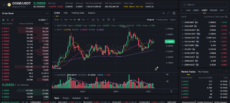
Binance’s popular spot exchange charges a maximum trading commission of just 0.1%. Source: Binance
Then select between a limit or market order depending on the strategy. Traders place market orders for instant execution at the next best available price. Limit orders offer additional flexibility, as traders set the entry price, which executes only when triggered. Confirm the order, and once executed, Binance adds the purchased assets to your spot account.
Beginners might prefer Binance’s conversion tool. While fees are higher, the tool enables instant swaps without needing to set up or place orders.
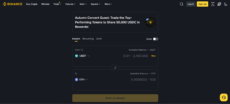
Binance’s conversion tool supports instant swaps without spot exchange orders. Source: Binance
Hover over “Trade” and click “Convert and Block Trade”. Input the “From” and “To” assets, alongside the trade amount. Binance displays the exchange rate immediately based on those parameters. After you review the quote and confirm the trade, Binance executes it right away.
How to Sell Coins and Withdraw Funds on Binance
To cash out a Binance position, go back to the pair’s trading page. Then set up a market or limit order and complete the trade. The exchange adds the receiving asset to your Binance spot account.
You can then withdraw that asset to a private wallet. In the wallet section, click “Withdraw” and select the coin or token to transfer. Ensure you choose the correct network and paste the destination wallet address. Binance approves withdrawal requests near-instantly.

Binance usually approves crypto withdrawals in minutes. Source: Binance
While Binance also supports fiat withdrawals, availability varies by currency.
Search the spot exchange for a suitable pair. For example, Europeans can swap major cryptocurrencies like USDT and BTC for EUR. Once sold, click “Withdraw Fiat” in the account’s wallet section, then choose a suitable withdrawal method, such as bank transfer or debit/credit card.

Binance allows users in some countries to withdraw fiat money. Source: Binance
Another method is selling cryptocurrencies on Binance’s P2P exchange. Set up the trade parameters, like the cash-out asset and preferred withdrawal method, and Binance lists available sellers in your home country.
BNB Coin & Its Relation to Binance
Binance’s native exchange token, BNB, is one of the largest cryptocurrencies by market capitalization. Here are BNB’s key features on the Binance platform:
- Trading Fee Discounts: Binance users who hold BNB receive a 25% discount on spot trading commissions, and 10% on perpetual and delivery futures.
- Launchpool Events: To join new Binance launchpool events, investors must stake BNB. They receive the project’s tokens via airdrop campaigns.
- BNB Chain Ecosystem Tokens: BNB Chain is a popular blockchain ecosystem that hosts thousands of cryptocurrencies. Traders swap BNB for new tokens on decentralized exchanges (DEXs) like PancakeSwap.
- DeFi Rewards: BNB holders may stake their assets through the proof-of-stake mechanism. This process enables holders to earn passive rewards. Binance, among other exchanges, lets users earn competitive APYs on BNB savings accounts.
- Investment Coin: As one of the best-performing cryptocurrencies, some investors hold BNB to profit from potential price increases. Exchange data confirms that the BNB price has risen by over 1 million percent since its 2017 launch.
Our Binance Review Methodology
Our transparent research methods help everyday consumers make informed decisions. We opened a Binance account, completed the KYC process, and funded it with fiat money and digital assets.
The team tested each Binance trading product, from the spot exchange and instant conversions to futures and options markets, on desktop and mobile devices. This helped us evaluate user-friendliness, liquidity depth, average bid-ask spreads, and trade execution speeds.
After reviewing trading and non-trading fees for each account tier and market, we assessed the exchange’s safety mechanisms. Our researchers checked Binance’s regulatory status, proof of reserves, and account security features.
To produce a fair and unbiased Binance review, we compared our findings with other top crypto exchanges like OKX, Crypto.com, MEXC, Coinbase, and Gemini.
Binance Review: Final Verdict
Our Binance review confirms the exchange handles significant trading volumes across hundreds of cryptocurrencies. While some exchange competitors offer slightly lower fees, Binance reduces commissions when traders hold BNB or increase the account tier. The maximum spot exchange commission of 0.1% remains competitive.
Besides spot trading, Binance offers a huge selection of derivative markets, including options and perpetual futures with 150x leverage. Most accepted nationalities access fiat services, so beginners may buy digital assets with local money. The standout feature remains Binance’s world-class trading tools, which include bots, custom charts, indicators, and bespoke order types.
FAQ
Who owns Binance?
When was Binance founded?
Is Binance trustworthy?
Does Binance have a demo account?
Can you use Binance from the US?
Which countries are accepted by Binance?
How long does it take to withdraw from Binance?
Is Binance the best crypto exchange?
What are the pros and cons of Binance?
References
- Binance Terms of Service (Binance)
- Binance U.S. Licenses (Binance.US)
- Binance Nears Deal to Escape Compliance Monitor Imposed by DOJ (Bloomberg)
- Australia watchdog orders Binance unit to conduct audit over money laundering concerns (Bloomberg)
Coinspeaker in Numbers
Monthly Users
Articles & Guides
Research Hours
Authors
This guide covers the presale timeline, token economics, launch plans, and the key features that set PEPETO apart from other meme ...
MoonBull’s presale is live with multiple stages through 2025, and the Token Generation Event (TGE) is projected for Q1 2026. Knowi...
 Fact-Checked By:
Fact-Checked By:
 24 mins
24 mins
Otar Topuria
Crypto Editor, 21 postsI’m a crypto writer and analyst at Coinspeaker with over three years of experience covering fintech and the rapidly evolving cryptocurrency landscape. My work focuses on market movements, investment trends, and the narratives driving them, helping readers what is happening in the markets and why. In addition to Coinspeaker, my insights and analyses have been featured in other leading crypto and fintech publications, where I’ve built a reputation as a thoughtful and reliable voice in the industry.
My mission is to demystify the crypto markets and help readers navigate the noise, highlighting the stories and trends that truly matter. Before specializing in crypto, I worked in the IT sector, writing technical content on software development, digital innovation, and emerging technologies. That made me something of an expert in breaking down complex systems and explaining them in a clear, accessible way, skills I now find very useful when it comes to unpacking the intricate world of blockchain and digital assets.
I hold a Master’s degree in Comparative Literature, which sharpened my ability to analyze patterns, draw connections across disciplines, and communicate nuanced ideas. I’m particularly passionate about early-stage project discovery and crypto trading, areas where innovation meets opportunity. I enjoy exploring how new protocols, tokens, and DeFi projects aim to disrupt traditional systems, while also evaluating their potential risks and rewards. By combining market analysis with forward-looking research, I strive to provide readers with content that is both informative and actionable.